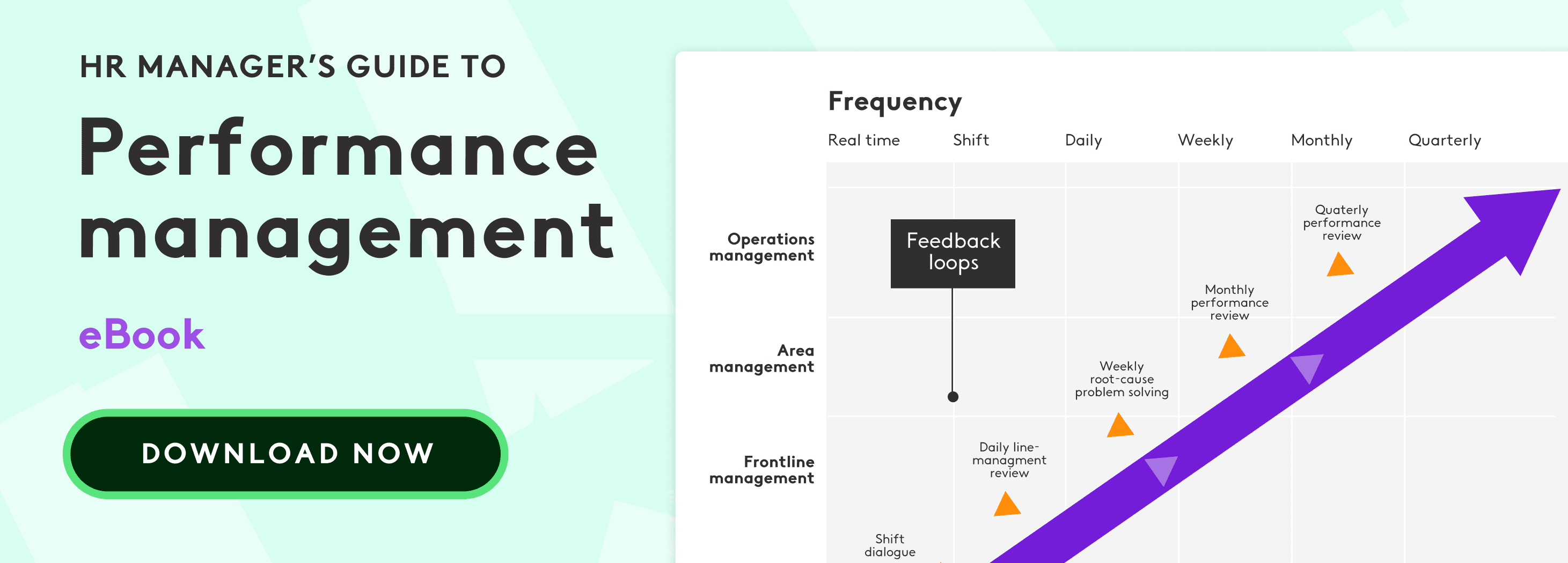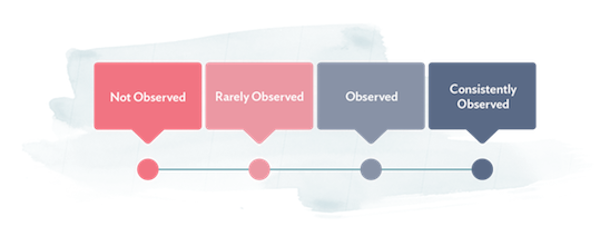Rating scales for performance reviews are the means to an end: to evaluate performance for employees. Without them, we cannot accurately and objectively determine their strengths and weaknesses.
What are they? What are they used for, exactly? Which one should you choose? Can you create your own? We answer all of these questions below.
What are performance appraisal rating scales?
A performance appraisal system enables you to assess your employees’ level of the specific knowledge, skills or competencies they need to carry out their job.
The scale represents a range which is used to measure different criteria. For example:
- From “below average” to “excellent.”
- From “unsatisfactory” to “highly satisfactory.”
- From 0 to 10.
- From “never” to “always.”
- From “beginner” to “expert.”
- From 0% to 100%.
Measurement scales can also be visual. An extremely popular example would be the five-star rating system, with one star being the lowest and five stars being the highest. Or forks, in the case of restaurants.
The importance of defining a rating scale
Defining a measurement scale is just as important as knowing how well your employees are working in your company. It’s a means towards an extremely important strategic end. Without a clear and common rating scale, we cannot evaluate our team’s performance.
This is also important from the employee perspective as they want to know if they are producing quality work and what is expected of them. It gives them an idea about their strengths, weaknesses and where to focus their energies to grow professionally within the company.
And rating scales for performance reviews also bring subjectivity and transparency to the process because they are based on predefined indicators. They help managers explain and justify their people-based decisions.
Indeed, some of the most common problems with performance appraisals we come across are the reviewer’s lack of subjectivity and the influence of personal bias. A clear and simple scoring system will avoid these obstacles.

How to create a performance appraisal rating scale for your company
Creating your own performance appraisal rating scale will help you obtain useful information and reduce the most common biases. This is also an opportunity for you to focus on the attributes and values that the organisation wishes to encourage.Remember that you can dowload our employee performance review template.
Here are three tips to bear in mind when developing your own scale:
Tip 1: Understand variance and validity
Variance and validity are two areas that can weaken many measurement scales.
- Variance: if we use a measurement scale to evaluate the performance of different people, does this identify the different nuances in their performance? It's vital to design a measurement method with well-defined multiple-choice options, as well as providing training for reviewers.
- Validity: here we must ask ourselves if the scale measures what we say it does, or if it actually matters to the organisation. And, secondly, we must assess whether the results obtained help us to make better decisions based on subjective data.
In general, we must always ensure that our scale and its response options do lead to significant and relevant results.
Tip 2: Customise the wording
It’s essential to ensure that the scale we create is aligned to the company culture, its brand and commercial objectives. This means customising the wording, question design and response options according to measurement criteria.
The more specific we are when defining every response option, the better and more consistent the data obtained will be. Creating clear descriptions becomes even more important as we increase the number of response options.
Let’s look at an example:
- Question: Would you like this person in your team?
- Answers: Absolutely not / No / Yes / Absolutely
In this example, we avoid errors in performance appraisals by offering clear and simple options that leave no room for neutrality.
If we use performance review software to conduct appraisals, it must give you the option of customising the questionnaire. Many software platforms provide standard forms: nevertheless, the company should have the ability to personalise the performance appraisal questions, as well as the answer, to suit their needs.
Tip 3: Communicate and educate
Finally, prepare to share the scales that will be used and inform your team about each one. The foundation of good measurement is ensuring that everyone understands how to assess their colleagues and how success is defined.
Transparency helps to generate trust and equity about how employees are measured. Failure to inform your workforce about the measurement systems that’ll be used could be one of the biggest mistakes you make.

Graphic rating scales for performance appraisals
While the best advice is to use your own performance appraisal scale, you can always use or get inspiration from existing ones. Here are some examples of the most common scales.
1. Likert scale
The Likert scale, in human resources, is used to measure attitudes and gauge the extent to which an employee agrees with an assertion.
For example:
- Question: Are you satisfied with the performance of the employee (under review)?
- Possible answers: Strongly disagree / Disagree / Neutral / Agree / Strongly agree.

If we want to adopt a similar model the scale must be symmetrical. This means that there should be an equal number of positive and negative answers. We can separate them by a more neutral option if we prefer.
The most common type of scale used has five options, but any number is acceptable as long as they fulfil the above conditions. At Harvard, for example, they use a five-option scale to observe their employees’ performance: leading (5) / strong (4) / solid (3) / building (2) / and not meeting expectations (1).
If it has an odd number, the central option will usually be the most neutral. If the number is even, it is sometimes referred to as “forced choice”, as it doesn’t provide the opportunity to choose an intermediate response.
2. Three-point scale
The three-point scale has three possible answers that usually represent two opposite choices, and one neutral.
- Below expectations: needs to improve their results and maybe take extra training.
- Meets expectations: constantly satisfies expectations and sometimes exceeds them.
- Exceeds expectations: Always achieves their objectives and even has a positive influence on others.
While this kind of scale can work to measure certain criteria, is often lacks the nuances required to perform an evaluation. This is why using five possible answers can give a much clearer view of someone’s performance.
3. Semantic differential scale
In this case, we use two options on opposite ends of the scale and the reviewer indicates at which point their opinion lies. They can position themselves at either end of the scale, or somewhere in the middle. Example:
- Question: How would you rate the employee’s communication skills?
- Answer: Poor communicator _____ _____ _____ _____ _____ _____ _____ Good communicator.
Reviewers are asked to mark one of seven empty spaces that are usually left between each end.
4. Soft skills assessment scale
Soft skills are a combination of social and communication skills, personality traits, attitude, professional attributes, social and emotional intelligence that enable someone to navigate their environment, work with others, do a good job, etc.
And as suggested by Culture Amp, you can use an observation scale to measure an employee’s interpersonal skills. With this type of scale, the reviewer has to indicate how often an employee demonstrates the desired behaviour. For this to work, it’s critical that both people work closely enough together to be able to have a well-formed opinion.

In conclusion: rating scales for performance reviews are essential tools in every appraisal. Which one you choose will depend on the company’s needs and your measurement objectives.





